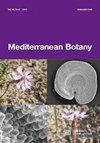Allium goumenissanum (Allium sect. Codonoprasum), a new species for Bulgaria and new localities in Greece: testing an integrated approach to species identification
IF 0.7
4区 生物学
Q3 PLANT SCIENCES
引用次数: 0
Abstract
Allium sect. Codonoprasum represents an evolutionarily young and rapidly radiating group of bulbous geophytes, with a significant proportion of polyploids and minor morphological differences between species. In the last 20 years, dozens of new species of this section have been described from the Mediterranean. Still, very little new information has been obtained on most of them since their description, especially concerning cytogenetic, molecular, and distribution data. Allium goumenissanum is a recently described species of this section, known only from three nearby localities in northern Greece. During the last 10 years, the senior authors' team collected population samples of an unknown species of this section from the southern Balkans, which appeared to be representative of A. goumenissanum. Using an integrated approach employing a range of methods (cytogenic, molecular, morpho- and micromorphological methods), the populations of an unknown species were compared with morphologically similar species A. goumenissanum and A. stamatiadae. AFLP, ITS sequencing and genome size analyses revealed that all the populations of the unknown species represent A. goumenissanum, and that this species is differentiated genetically and in genome size from A. stamatiadae. ITS sequencing indicates an allotriploid origin of A. goumenissanum from unknown ancestors. The characterization of the morphology and reproduction of A. goumenissanum is completed and micromorphological and anatomical characteristics of the leaves of both species are newly published. The distribution of A. goumenissanum, based on new data, now includes a more extensive area of north central Greece and the species has been found as a new one for Bulgaria.保加利亚新种 Allium goumenissanum (Allium sect. Codonoprasum) 和希腊新产地:测试物种鉴定的综合方法
薤白科Codonoprasum 代表了一个进化年轻、辐射迅速的球根地生植物群落,多倍体占很大比例,物种之间的形态差异很小。在过去的 20 年中,地中海地区描述了数十个该科的新物种。不过,自描述以来,关于其中大多数物种的新信息,特别是细胞遗传学、分子和分布数据,仍然很少。Allium goumenissanum 是新近描述的该区系的一个物种,仅从希腊北部附近的三个地方知道它的存在。在过去 10 年中,资深作者的团队从巴尔干半岛南部采集了该部分一个未知物种的种群样本,该样本似乎是 A. goumenissanum 的代表。采用综合方法(细胞学、分子学、形态学和微形态学方法),将未知物种的种群与形态上相似的物种 A. goumenissanum 和 A. stamatiadae 进行了比较。AFLP、ITS 测序和基因组大小分析表明,该未知物种的所有种群均代表 A. goumenissanum,而且该物种在基因组和基因组大小上与 A. stamatiadae 有所区别。ITS 测序表明,A. goumenissanum 起源于未知祖先的异源三倍体。goumenissanum 的形态和繁殖特征的研究已经完成,并新发表了这两个物种叶片的微观形态和解剖特征。根据新的数据,A. goumenissanum 的分布现在包括了希腊中北部更广阔的地区,该物种也被发现为保加利亚的新物种。
本文章由计算机程序翻译,如有差异,请以英文原文为准。
求助全文
约1分钟内获得全文
求助全文
来源期刊

Mediterranean Botany
Agricultural and Biological Sciences-Plant Science
CiteScore
2.40
自引率
10.00%
发文量
30
审稿时长
12 weeks
期刊介绍:
Mediterranean Botany (ISSNe 2603-9109), formerly Lazaroa, is a biannual journal that publishes original research studies in the field of Botany including plant systematics, vegetation ecology, biogeography, evolutionary biology, ecophysiology, community ecology, ethnobotany and conservation biology on Mediterranean biomes but also in interacting areas.
Mediterranean Botany is an OPEN ACCESS Journal, free of charges for any published article.
 求助内容:
求助内容: 应助结果提醒方式:
应助结果提醒方式:


